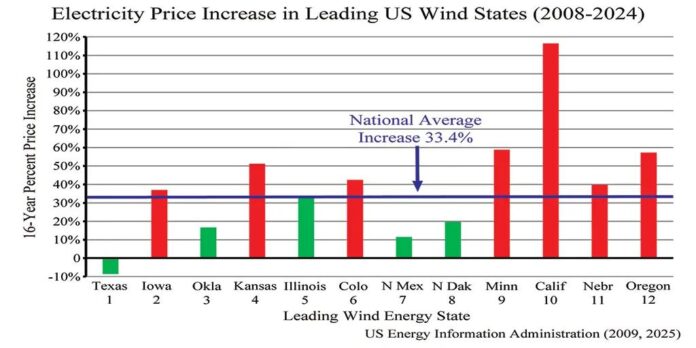By Steve Goreham
Originally published in The Wall Street Journal.
Electricity prices are rising, and Democrats blame President Trump. For years, articles in the media have said that renewables provide the lowest-cost electricity, claiming that wind and solar generators were cheaper than coal, natural gas, and nuclear. But prices are soaring in green energy states that install wind and solar and close coal plants.
Rahm Emanual, former Democrat mayor of Chicago and White House chief of staff, recently said that bigger electric bills “are a direct result of the One Big Beautiful Bill Act (OBBB), which cut green energy subsidies.” But the OBBB became law in July, subsidy cuts don’t take place until 2027, and power prices have been rising for many years while subsidies were in place. Green energy states obsessed with climate policies are suffering from escalating prices.
Data from the US Department of Energy (DOE) show that electricity prices in California, Connecticut, Maine, Maryland, Massachusetts, and New York have risen more than 30 percent in the last five years compared with just 22.5% nationally. Because of climate policies, these states closed their coal-fired power plants over the last 15 years, with the exception of one coal plant in Maryland and one in Maine. In comparison, prices in Georgia, Florida, Missouri, Texas and other states hampered less by green energy initiatives are rising less than the U.S. average. These states continue to be more friendly to lower-cost hydrocarbon fuels for electricity generation.

California’s electricity prices are up 59% over the last five years. The state closed all but one of its coal plants and all nuclear facilities except the Diablo Canyon plant. California now has the nation’s second highest residential electricity prices at 31.9 cents per kilowatt-hour, almost double the national price of 16.5 cents. The state’s massive investment in renewable sources, which accounted for more than half of California’s in-state electricity generation in 2024, has driven the price jump.
Power prices in Massachusetts are up 31% over the last five years. Residential prices are 29.4 cents/kWh, the third highest in the nation. The state produces only about half of the electricity it produced in 2010 because of closures of coal plants and the Pilgrim nuclear plant in 2019. Commercial and residential solar provided about one-fourth of Massachusetts power generation in 2024. Plans call for all new generating capacity to be wind and solar.
Surging electricity prices were a top issue in the New Jersey gubernatorial election. Candidates Jack Cittarelli and Mikie Sherrill both criticized the power policies of retiring governor Phil Murphy. Driven by green energy goals, New Jersey closed one nuclear plant, five coal plants, and two gas plants during the terms of governors Murphy and Chris Christie. Because of the plant closures, the state must now import about one-fifth of its power from other states. Both Murphy and Christie promoted offshore wind, but these projects are now stalled due to rising costs and Trump Administration opposition.
Green policies have created a costly natural-gas shortage in New England. In 2024, gas generated 55% of electricity for New England homes. But for more than a decade, New York blocked the construction of gas pipelines to New England in an effort to decarbonize. To reduce the shortage, the region imports liquified natural gas from Canada and overseas locations at higher prices.
The lack of pipelines forces residents in Connecticut and other New England states to pay as much as double the price for gas compared to residents in other states. Connecticut electricity prices have climbed 31% in the past five years largely because of gas restrictions. The Trump Administration is pushing to revive the Constitution and NESE pipelines to bring lower-cost gas to New England, projects that were blocked by New York.
New York electricity prices rose 37% over the last five years. The New York State Scoping Plan calls for 70% renewable electricity by 2030 and 100% zero-emissions electricity by 2040. The state closed its last coal plant and also the Indian Point nuclear plant in 2020, planning to generate increasing output from wind and solar sources. But renewables have not grown fast enough and the New York Independent System Operator now warns of a growing power shortfall.
Power prices in Florida, Georgia, Missouri, and Texas have risen 21% or less over the last five years. These states continue to rely on lower-cost hydrocarbon fuels for electricity generation: Florida (73% gas, 6% coal), Georgia (41% gas, 16% coal), Missouri (14% gas, 67% coal), and Texas (54% gas, 21% coal).
Other DOE data shows that, in most cases, electricity prices in the leading wind states are rising faster than the national average. From 2008 to 2024, national prices rose 33.4%, with most of the increase over the last five years. But power prices in seven of the top 12 wind states rose faster than the national average, including California (116%), Minnesota (59%), Oregon (57%), Kansas (51%), Colorado (42%), Nebraska (40%), and Iowa (37%). Wind is more expensive than traditional electricity sources because wind uses huge amounts of land, requires two or three times as much transmission infrastructure, and is intermittent, requiring backup from dispatchable power plants.

Democrats should stop blaming Republicans for soaring energy prices in blue states that their own green energy policies cause. If they want prices to reverse course, then they should use the electricity sources that are actually cheaper.
Steve Goreham is a speaker on energy, the environment, and public policy and author of the bestselling book Green Breakdown: The Coming Renewable Energy Failure.
Discover more from Watts Up With That?
Subscribe to get the latest posts sent to your email.



